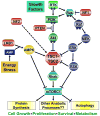Common corruption of the mTOR signaling network in human tumors
- PMID: 19956179
- PMCID: PMC3752670
- DOI: 10.1038/onc.2009.352
Common corruption of the mTOR signaling network in human tumors
Abstract
The mammalian target of rapamycin (mTOR) is responsive to numerous extracellular and intracellular cues and, through the formation of two physically and functionally distinct complexes, has a central role in the homeostatic control of cell growth, proliferation and survival. Through the aberrant activation of mTOR signaling, the perception of cellular growth signals becomes disconnected from the processes promoting cell growth, and this underlies the pathophysiology of a number of genetic tumor syndromes and cancers. Here, we review the oncogenes and tumor suppressors comprising the regulatory network upstream of mTOR, highlight the human cancers in which mTOR is activated and discuss how dysregulated mTOR signaling provides tumors a selective growth advantage. In addition, we discuss why activation of mTOR, as a consequence of distinct oncogenic events, results in diverse clinical outcomes, and how the complexity of the mTOR signaling network might dictate therapeutic approaches.
Figures

References
-
- Brown EJ, Albers MW, Shin TB, Ichikawa K, Keith CT, et al. A mammalian protein targeted by G1-arresting rapamycin-receptor complex. Nature. 1994;369:756–758. - PubMed
-
- Carriere A, Cargnello M, Julien LA, Gao H, Bonneil E, Thibault P, et al. Oncogenic MAPK signaling stimulates mTORC1 activity by promoting RSK-mediated raptor phosphorylation. Curr Biol. 2008;18:1269–1277. - PubMed
-
- Castellvi J, Garcia A, Rojo F, Ruiz-Marcellan C, Gil A, Baselga J, et al. Phosphorylated 4E binding protein 1: a hallmark of cell signaling that correlates with survival in ovarian cancer. Cancer. 2006;107:1801–1811. - PubMed
Publication types
MeSH terms
Substances
Grants and funding
LinkOut - more resources
Full Text Sources
Other Literature Sources
Miscellaneous

